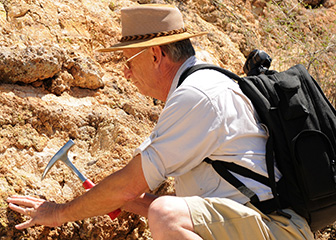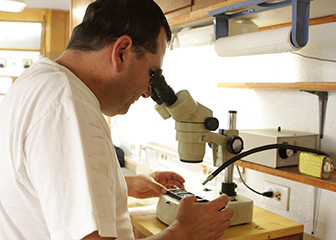
Petroleum geologists (a type of geoscientist) search for oil and gas deposits that are suitable for commercial extraction.
Geoscientists study the physical aspects of the Earth, such as its composition, structure, and processes, to learn about its past, present, and future.
Duties
Geoscientists typically do the following:
- Plan and conduct field studies, in which they visit locations to collect samples and conduct surveys
- Analyze aerial photographs, well logs (detailed records of geologic formations found during drilling), and other data to locate natural resource deposits and estimate their size
- Conduct laboratory tests on samples collected in the field
- Produce geologic maps and charts
- Prepare written scientific reports
- Present their findings to clients, colleagues, and other interested parties
- Review reports and research done by other scientists
Geoscientists use a wide variety of tools, both simple and complex. In a day in the field, they may use a hammer and chisel to collect rock samples and then use sophisticated radar equipment to search for oil underground. In laboratories, they may use x rays and electron microscopes to determine the chemical and physical composition of rock samples. They also use remote sensing equipment to collect data and advanced geographic information systems (GIS) and modeling software to analyze data.
Geoscientists often supervise the work of technicians, both in the field and in the lab. They also usually work as part of a team with other scientists and engineers. For example, they work closely with petroleum engineers to find and develop new sources of oil and natural gas.
Many geoscientists are involved in the search for and development of natural resources and minerals such as petroleum. Others work in environmental protection and preservation and are involved in projects to clean up and reclaim land. Some specialize in a particular aspect of the Earth, such as its oceans.
The following are examples of types of geoscientists:
Engineering geologists apply geologic principles to civil and environmental engineering. They offer advice on major construction projects and help in other projects, such as environmental cleanup and reducing natural hazards.
Geologists study the materials, processes, and history of the Earth. They investigate how rocks were formed and what has happened to them since their formation.
Geochemists use physical and organic chemistry to study the composition of elements found in groundwater, such as water from wells or aquifers, and earth materials, such as rocks and sediment.
Geophysicists use the principles of physics to learn about the Earth’s surface and interior. They also study the properties of Earth’s magnetic, electric, and gravitational fields.
Oceanographers study the motion and circulation of ocean waters; the physical and chemical properties of the oceans; and how these properties affect coastal areas, climate, and weather.
Paleontologists study fossils found in geological formations to trace the evolution of plant and animal life and the geologic history of the Earth.
Petroleum geologists explore the Earth for oil and gas deposits. They analyze geological information to identify sites that should be explored. They collect rock and sediment samples from sites through drilling and other methods and test them for the presence of oil and gas. They also estimate the size of oil and gas deposits and work to develop sites to extract oil and gas.
Seismologists study earthquakes and related phenomena like tsunamis. They use seismographs and other instruments to collect data on these events.
For a more extensive list of geoscientist specialties, visit the American Geological Institute.
People with a geosciences background may become professors or teachers. For more information, see the profile on postsecondary teachers.













